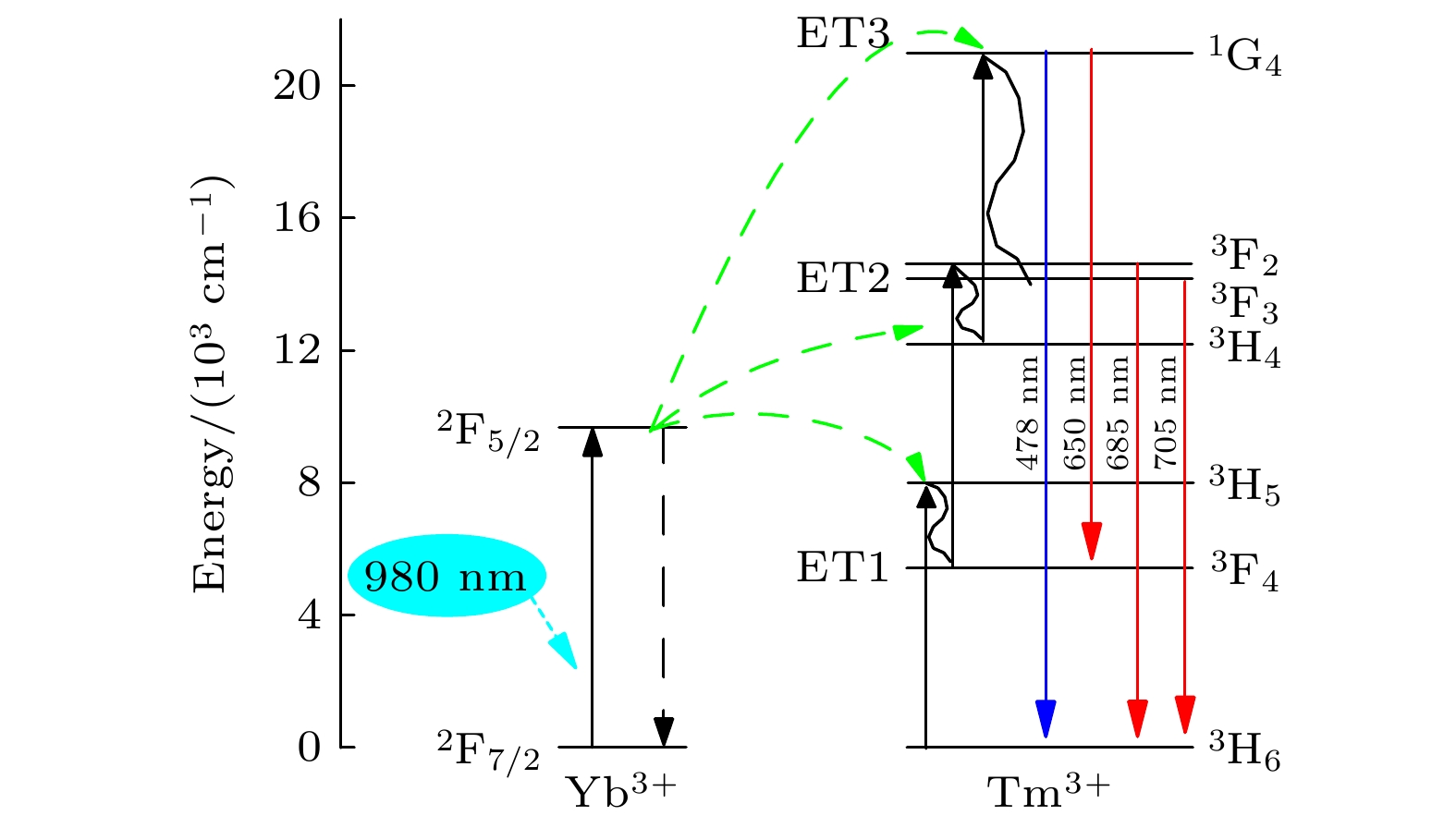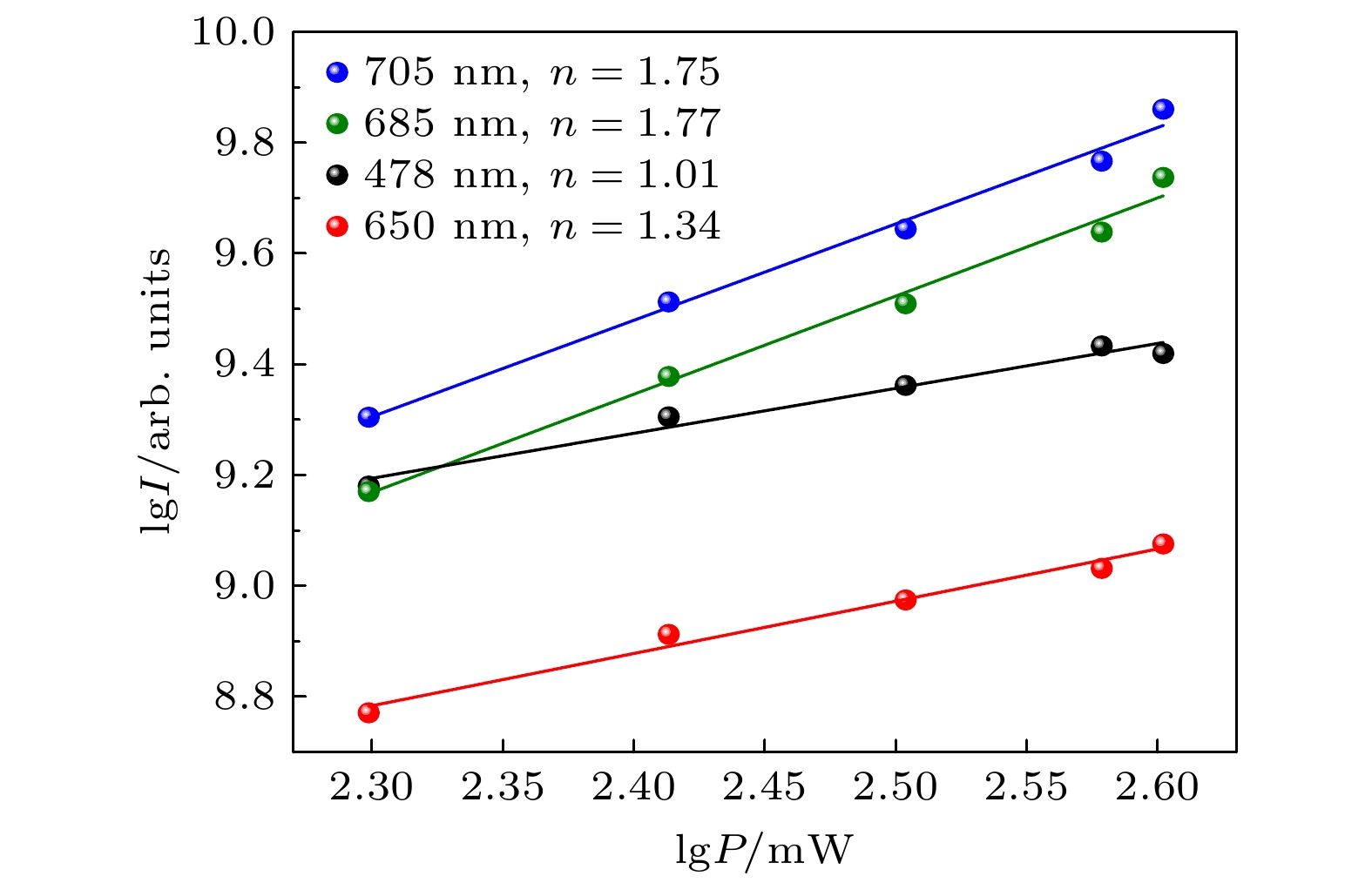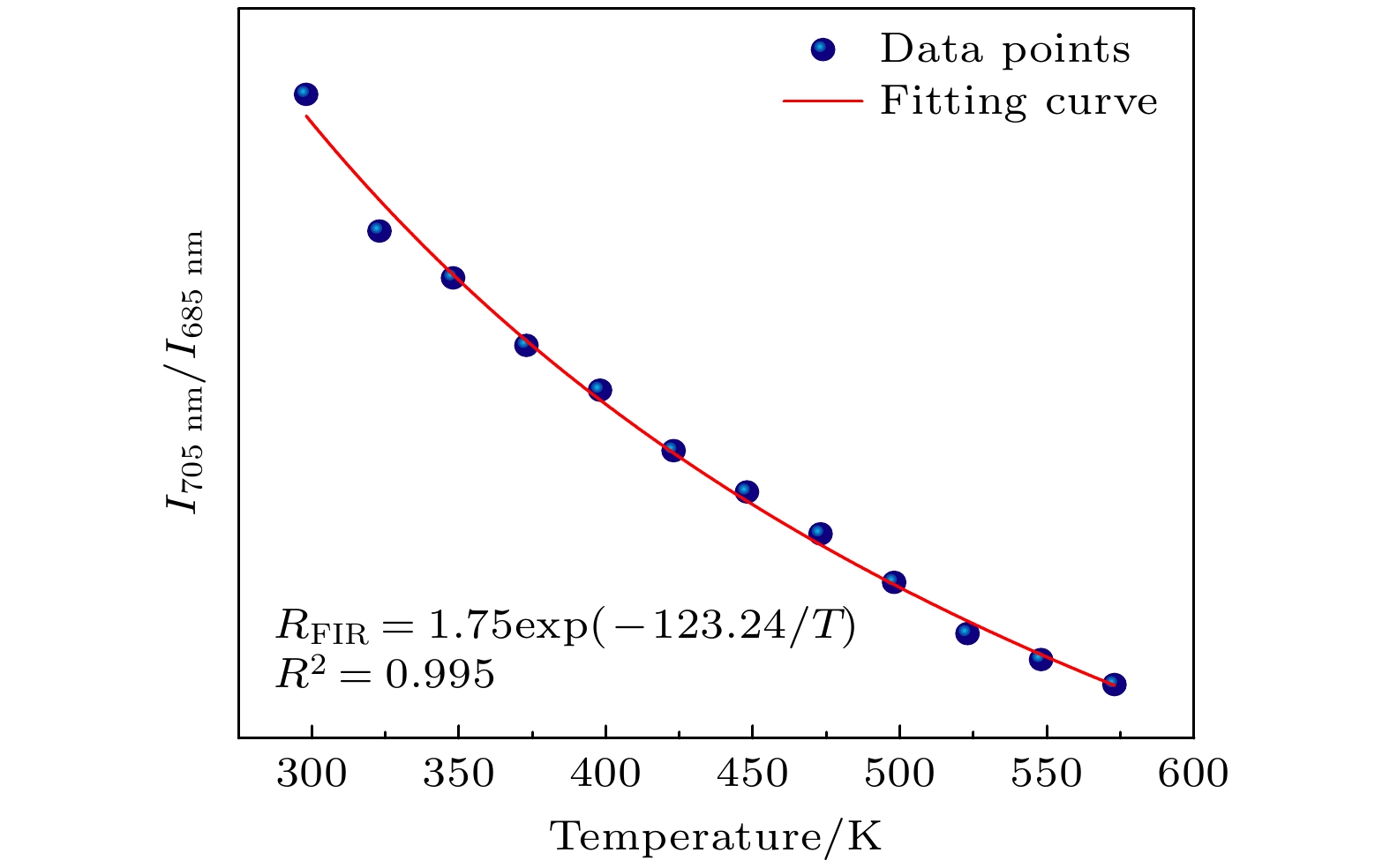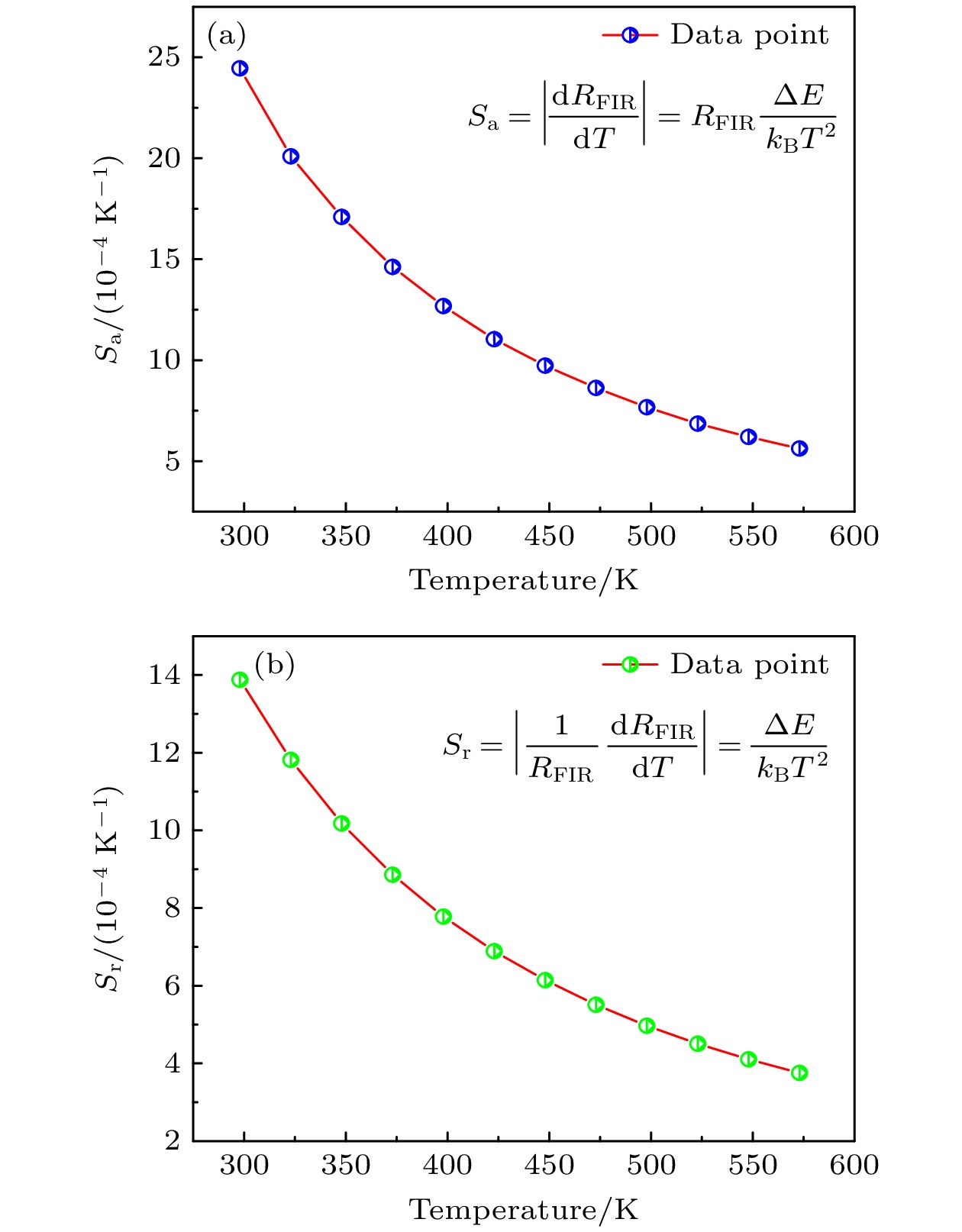-
Tm3+ and Yb3+, with different concentrations, co-doped Bi2WO6 up-conversion luminescence materials are prepared by high temperature solid state method. The microstructure, upconversion emission spectra, and optical temperature sensing properties of the synthesized powders are characterized and analyzed. The X-ray diffraction results show that the doping of Tm3+ and Yb3+ ions has little effect on the orthorhombic structure of Bi2WO6 matrix material. Under the 980 nm excitation, the maximum emission intensity of Tm3+ ions is obtained when the doping concentration of Tm3+ and Yb3+ are 1% and 6%, respectively. The intensities of four emission peaks of Tm3+ in 1%Tm3+, 6%Yb3+:Bi2WO6 sample increase with the excitation pump power increasing from 199 to 400 mW. With the excitation power of 199–400 mW, the sample light intensity I and the excitation power Pn show a linear relationship. The relationship between the excitation pump power and the emission intensity of Tm3+ in this range is investigated. The four emission peaks of Tm3+ at 478, 650, 685 and 705 nm correspond to the n values of 1.01, 1.34, 1.77 and 1.75, respectively, indicating that the above emission peaks are derived from two-photon absorption. Under 980 nm excitation (power 379 mW), when the temperature increases from 298 to 573 K, the thermal coupling energy levels of Tm3+ in 1%Tm3+, 6%Yb3+:Bi2WO6 samples produce 705 and 685 nm emission whose intensities are increased by 28.4 times and 31.6 times, respectively. The relationship between the fluorescence intensity ratio of the thermal coupling energy levels (3F3, 3F2) of Tm3+ in the sample and the temperature is fitted. The maximum absolute temperature sensitivity of the sample is 0.00254 K–1 at 298 K, and the maximum relative temperature sensitivity is 0.00144 K–1. Under the same conditions, the relationship between the fluorescence intensity ratio of 705 and 650 nm produced by the non-thermal coupling energy level pair (3F3, 1G4) and the temperature is fitted, and the maximum absolute temperature sensitivity is calculated to be 0.167 K–1 at 573 K. The maximum relative temperature sensitivity is 0.0378 K–1 at 298 K, which is 26 times higher than the relative maximum temperature sensitivity Sr of the thermal coupling level (3F3, 3F2).
-
Keywords:
- upconversion luminescence /
- thermally coupled energy level /
- non-thermally coupled energy level /
- temperature measurement sensitivity
[1] Ruiz D, Rosal B, Acebrón M, et al. 2017 Adv. Funct. Mater. 27 1604629
 Google Scholar
Google Scholar
[2] 周慧丽, 吴锋, 张志宏, 张雁, 叶林华 2022 发光学报 43 192
 Google Scholar
Google Scholar
Zhou H L, Wu F, Zhang Z H, Zhang Y, Ye L H 2022 Chin. J. Lumin. 43 192
 Google Scholar
Google Scholar
[3] 谢宇 2016 硕士学位论文 (沈阳: 辽宁大学)
Xie Y 2016 M. S. Thesis (Shenyang: Liaoning University) (in Chinese)
[4] 吴中立, 吴红梅, 唐立丹, 李煜, 郭宇, 姚震 2017 光子学报 46 0916003
 Google Scholar
Google Scholar
Wu Z L, Wu H M, Tang L D, Li Y, Guo Y, Yao Z 2017 Acta Photonica Sin. 46 0916003
 Google Scholar
Google Scholar
[5] Xing J H, Shang F, Chen G H 2021 J. Non-Cryst. Solids 569 120989
 Google Scholar
Google Scholar
[6] Saidi K, Dammak M, Soler-Carracedo K, Martín I 2022 Dalton Trans. 51 5108
 Google Scholar
Google Scholar
[7] Meng M Z, Zhang R, Fa X M, et al. 2022 CrystEngComm 24 1752
 Google Scholar
Google Scholar
[8] Zhuang Y F, Wang D W, Yang Z P 2022 Opt. Mater. 126 112167
 Google Scholar
Google Scholar
[9] Zheng T, Runowski M, Stopikowska N, Skwierczyńska M, Lis S, Du P, Luo L H 2021 J. Alloys Compd. 890 161830
 Google Scholar
Google Scholar
[10] 蒙铭周, 张瑞, 法信蒙, 杨江华, 欧俊 2021 发光学报 42 1763
 Google Scholar
Google Scholar
Meng M Z, Zhang R, Fa X M, Yang J H, Ou J 2021 Chin. J. Lumin. 42 1763
 Google Scholar
Google Scholar
[11] 郑龙江, 李雅新, 刘海龙, 徐伟, 张志国 2013 62 240701
 Google Scholar
Google Scholar
Zheng L J, Li Y X, Liu H L, Xu W, Zhang Z G 2013 Acta Phys. Sin. 62 240701
 Google Scholar
Google Scholar
[12] Wu Z L, Zhang Y P, Bao D M, Li H Q, Hou X Q, Wang J L 2022 J. Lumin. 245 118766
 Google Scholar
Google Scholar
[13] Lü H C, Du P, Li W P, Luo L H 2022 ACS Sustainable Chem. Eng. 10 2450
 Google Scholar
Google Scholar
[14] Gao Z L, Wang J R, Yu D C, Pun E Y B, Lin H 2022 Adv. Mater. Interfaces 9 2101869
 Google Scholar
Google Scholar
[15] 张志宏, 周慧丽, 吴锋, 张雁, 叶林华 2021 发光学报 42 1872
 Google Scholar
Google Scholar
Zhang Z H, Zhou H L, Wu F, Zhang Y, Ye L H 2021 Chin. J. Lumin. 42 1872
 Google Scholar
Google Scholar
[16] Wang T W, Zhao S L, Lei R S, Huang L H, Xu S Q 2022 J. Non-Cryst. Solids 579 121379
 Google Scholar
Google Scholar
[17] Tong X, Zhou X, Tang X Z, Min Y G, Li X L, Wang W G, Qian Y N 2022 CrystEngComm 24 1407
 Google Scholar
Google Scholar
[18] Wang X F, Liu Q, Bu Y Y, Liu C S, Liu T, Yan X H 2015 RSC Adv. 5 86219
 Google Scholar
Google Scholar
[19] Liu Z H, Long S W, Zhu Y Z, Wang W J, Wang B 2020 J. Alloys Compd. 867 158986
 Google Scholar
Google Scholar
[20] Sun Z, Liu G F, Fu Z L, et al. 2018 Dyes Pigm. 151 287
 Google Scholar
Google Scholar
-
表 1 800 ℃下煅烧3 h合成不同浓度Tm3+, Yb3+共掺Bi2WO6材料
Table 1. Synthesis of Tm3+, Yb3+ co-doped Bi2WO6 materials with different doping concentration at the sintering temperature and time of 800 ℃ and 3 h.
Sample No. Mole fraction
of Tm3+/%Mole fraction
of Yb3+/%Mole fraction
of Bi2WO6/%1 0.5 6 93.5 2 1 6 93 3 1.5 6 92.5 4 2 6 92 5 1 4 95 6 1 8 91 7 1 10 89 表 2 不同基质材料中Tm3+温度传感性能
Table 2. Temperature sensing performance of Tm3+ in various host materials.
Host material Energy level Temperature range/K Relative temperature
measurement
sensitivity/K–1Ref. SiO2@Tm3+:NaYbF4 3F2, 3, 3H4→3H6 100—700 Max = 0.00054@298 K [18] Tm3+, Yb3+:LuYO3 3F2, 3F3→3H6 223—723 Max = 0.00461@516.3 K [15] Tm3+, Yb3+:LiNbO3 1G4→3F4, 3H4→3H6 80—260 Max = 0.0125@80 K [19] Tm3+, Yb3+:Bi3.84W0.16O6.24 3H4(1), 3H4(2)→3H6 323—573 Max = 0.00068@323 K [20] Li+, Tm3+, Yb3+:Bi3.84W0.16O6.24 3H4(1), 3H4(2)→3H6 323—573 Max = 0.00103@323 K Mg2+, Tm3+, Yb3+:Bi3.84W0.16O6.24 3H4(1), 3H4(2)→3H6 323—573 Max = 0.00070@323 K Tm3+, Yb3+:Bi2WO6 3F2, 3→3H6 298—573 Max = 0.00144@298 K This work 3F2, 3→3H6 313 0.0013 K–1 3F2, 3→3H6 323 0.0012 K–1 3F3→3H6 , 1G4→3F4 298—573 Max = 0.0378@298 K 3F3→3H6 , G4→3F4 313 0.0343 K–1 3F3→3H6, 1G4→3F4 323 0.0322 K–1 -
[1] Ruiz D, Rosal B, Acebrón M, et al. 2017 Adv. Funct. Mater. 27 1604629
 Google Scholar
Google Scholar
[2] 周慧丽, 吴锋, 张志宏, 张雁, 叶林华 2022 发光学报 43 192
 Google Scholar
Google Scholar
Zhou H L, Wu F, Zhang Z H, Zhang Y, Ye L H 2022 Chin. J. Lumin. 43 192
 Google Scholar
Google Scholar
[3] 谢宇 2016 硕士学位论文 (沈阳: 辽宁大学)
Xie Y 2016 M. S. Thesis (Shenyang: Liaoning University) (in Chinese)
[4] 吴中立, 吴红梅, 唐立丹, 李煜, 郭宇, 姚震 2017 光子学报 46 0916003
 Google Scholar
Google Scholar
Wu Z L, Wu H M, Tang L D, Li Y, Guo Y, Yao Z 2017 Acta Photonica Sin. 46 0916003
 Google Scholar
Google Scholar
[5] Xing J H, Shang F, Chen G H 2021 J. Non-Cryst. Solids 569 120989
 Google Scholar
Google Scholar
[6] Saidi K, Dammak M, Soler-Carracedo K, Martín I 2022 Dalton Trans. 51 5108
 Google Scholar
Google Scholar
[7] Meng M Z, Zhang R, Fa X M, et al. 2022 CrystEngComm 24 1752
 Google Scholar
Google Scholar
[8] Zhuang Y F, Wang D W, Yang Z P 2022 Opt. Mater. 126 112167
 Google Scholar
Google Scholar
[9] Zheng T, Runowski M, Stopikowska N, Skwierczyńska M, Lis S, Du P, Luo L H 2021 J. Alloys Compd. 890 161830
 Google Scholar
Google Scholar
[10] 蒙铭周, 张瑞, 法信蒙, 杨江华, 欧俊 2021 发光学报 42 1763
 Google Scholar
Google Scholar
Meng M Z, Zhang R, Fa X M, Yang J H, Ou J 2021 Chin. J. Lumin. 42 1763
 Google Scholar
Google Scholar
[11] 郑龙江, 李雅新, 刘海龙, 徐伟, 张志国 2013 62 240701
 Google Scholar
Google Scholar
Zheng L J, Li Y X, Liu H L, Xu W, Zhang Z G 2013 Acta Phys. Sin. 62 240701
 Google Scholar
Google Scholar
[12] Wu Z L, Zhang Y P, Bao D M, Li H Q, Hou X Q, Wang J L 2022 J. Lumin. 245 118766
 Google Scholar
Google Scholar
[13] Lü H C, Du P, Li W P, Luo L H 2022 ACS Sustainable Chem. Eng. 10 2450
 Google Scholar
Google Scholar
[14] Gao Z L, Wang J R, Yu D C, Pun E Y B, Lin H 2022 Adv. Mater. Interfaces 9 2101869
 Google Scholar
Google Scholar
[15] 张志宏, 周慧丽, 吴锋, 张雁, 叶林华 2021 发光学报 42 1872
 Google Scholar
Google Scholar
Zhang Z H, Zhou H L, Wu F, Zhang Y, Ye L H 2021 Chin. J. Lumin. 42 1872
 Google Scholar
Google Scholar
[16] Wang T W, Zhao S L, Lei R S, Huang L H, Xu S Q 2022 J. Non-Cryst. Solids 579 121379
 Google Scholar
Google Scholar
[17] Tong X, Zhou X, Tang X Z, Min Y G, Li X L, Wang W G, Qian Y N 2022 CrystEngComm 24 1407
 Google Scholar
Google Scholar
[18] Wang X F, Liu Q, Bu Y Y, Liu C S, Liu T, Yan X H 2015 RSC Adv. 5 86219
 Google Scholar
Google Scholar
[19] Liu Z H, Long S W, Zhu Y Z, Wang W J, Wang B 2020 J. Alloys Compd. 867 158986
 Google Scholar
Google Scholar
[20] Sun Z, Liu G F, Fu Z L, et al. 2018 Dyes Pigm. 151 287
 Google Scholar
Google Scholar
Catalog
Metrics
- Abstract views: 8805
- PDF Downloads: 106
- Cited By: 0















 DownLoad:
DownLoad:










